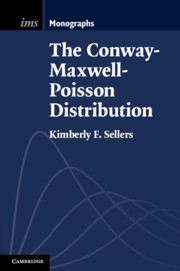Book contents
- Frontmatter
- Dedication
- Contents
- Figures
- Tables
- Preface
- Acknowledgments
- 1 Introduction: Count Data Containing Dispersion
- 2 The Conway–Maxwell–Poisson (COM–Poisson) Distribution
- 3 Distributional Extensions and Generalities
- 4 Multivariate Forms of the COM–Poisson Distribution
- 5 COM–Poisson Regression
- 6 COM–Poisson Control Charts
- 7 COM–Poisson Models for Serially Dependent Count Data
- 8 COM–Poisson Cure Rate Models
- References
- Index
6 - COM–Poisson Control Charts
Published online by Cambridge University Press: 02 March 2023
- Frontmatter
- Dedication
- Contents
- Figures
- Tables
- Preface
- Acknowledgments
- 1 Introduction: Count Data Containing Dispersion
- 2 The Conway–Maxwell–Poisson (COM–Poisson) Distribution
- 3 Distributional Extensions and Generalities
- 4 Multivariate Forms of the COM–Poisson Distribution
- 5 COM–Poisson Regression
- 6 COM–Poisson Control Charts
- 7 COM–Poisson Models for Serially Dependent Count Data
- 8 COM–Poisson Cure Rate Models
- References
- Index
Summary
While the Poisson model motivated much of the classical control chart theory for count data, several works note the constraining equi-dispersion assumption. Dispersion must be addressed because over-dispersed data can produce false out-of-control detections when using Poisson limits, while under-dispersed data will produce Poisson limits that are too broad, resulting in potential false negatives and out-of-control states requiring a longer study period for detection. Section 6.1 introduces the Shewhart COM–Poisson control chart, demonstrating its flexibility in assessing in- or out-of-control status, along with advancements made to this chart. These initial works lead to a wellspring of flexible control chart development motivated by the COM–Poisson distribution. Section 6.2 describes a generalized exponentially weighted moving average control chart, and Section 6.3 describes the cumulative sum charts for monitoring COM–Poisson processes. Meanwhile, Section 6.4 introduces generally weighted moving average charts based on the COM-Poisson, and Section 6.5 presents the Conway–Maxwell–Poisson chart via the progressive mean statistic. Finally, the chapter concludes with discussion.
Keywords
- Type
- Chapter
- Information
- The Conway–Maxwell–Poisson Distribution , pp. 218 - 250Publisher: Cambridge University PressPrint publication year: 2023

